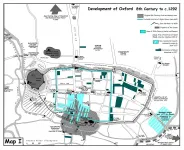"In 2014, I started working on the Muon g-2 experiment as a postdoctoral researcher at the University of Washington, Seattle," says Prof. Martin Fertl, who has been performing research in the field of low-energy particle physics at the PRISMA+ Cluster of Excellence since 2019. "That's why today's a truly special day. We can now announce a first result, while also stating that this result has opened the door even wider to a previously unknown physics."
The new experimental value published today of the anomalous magnetic moment of the muon is a(FNAL) = 116 592 040(54) x 10^(-11), with a relative uncertainty of 460 parts in a billion. Combined with the result of the experiment at Brookhaven National Laboratory completed more than 20 years ago, the new experimental mean value is a(Exp.,avg) = 116 592 061(41) x 10^(-11). This contrasts with the theoretical predicted value obtained from the Standard Model of a(Theor.) = 116 591 810(43) x 10^(-11). Physicists classify the difference between these two values as 4.2 standard deviations. In other words, the probability that this discrepancy between experiment and theory is due to chance is 0.0025 percent (1 in 40,000). Physicists consider a discovery - in this case, the refutation of the Standard Model - has been made when the probability is less than 0.00005 percent corresponding to 5 standard deviations.
Numerous contributions from Mainz - both experimental and theoretical
Martin Fertl's PRISMA+ work group is the only one in Germany that is involved in the Muon g-2 Collaboration in an experimental capacity. The collaborations "count erpart" is the "Muon g-2 Theory Initiative", a worldwide association of more than 130 physicists working on the theoretical prediction within the framework of the Standard Model. The initiative was established in 2017 as a means of joining forces to significantly reduce the uncertainty of the predicted value of the anomalous magnetic moment of the muon. "Just last year, we established a common standard for the first time and agreed on a new theoretical value worldwide," says Prof. Hartmut Wittig, theoretical physicist as well as spokesperson for the PRISMA+ Cluster of Excellence. "Our goal is, in parallel with the experiment, to keep refining the theoretical prediction as well." Physicists at PRISMA+ are making crucial contributions here, from the measurement of experimental input quantities to the high-precision calculation of the contributions of the strong interaction using lattice quantum chromodynamics methods on the MOGON-II supercomputer located in Mainz.
Is the experiment seeing something not predicted by the theory?
The first time a discrepancy - of 3.7 standard deviations - emerged was when the theoretical prediction was compared with the findings of the experiment at the Brookhaven National Laboratory, mentioned above. In the 20 years since then, the aim of research worldwide has been to establish whether this deviation is "real" or "merely" the result of systematic uncertainties in theory and experiment. The current Muon g-2 experiment was developed to measure the magnetic properties of the muon more accurately than ever before. The Muon g-2 Collaboration involves more than 200 scientists from 35 institutions in seven countries.
The muon is the heavy brother of the electron and survives for only a millionth of a fraction of a second. It possesses a magnetic moment, a kind of miniature internal bar magnet. It also possesses a quantum mechanical angular momentum, termed spin, similar to a spinning top. The g-factor is the ratio of the observed strength of the magnet to a simple estimate based on the electric charge, mass, and spin of the muon. The name of the Muon g-2 experiment is based on the fact that the "g" of the muon always deviates slightly - by about 0.1 percent - from the simple prediction that g=2. This anomaly is commonly referred to as the anomalous magnetic moment of the muon (a = (g-2)/2). The Muon g-2 experiment measures the rate of gyration of the "internal compass needle" of muons in a magnetic field, as well as the magnetic field itself, and from this it can determine the anomalous magnetic moment. The muon beam is generated at FNAL`s Muon Campus specifically for the experiment - it has a purity that has never been achieved before.
More than eight billion muons already measured
"Our first analysis, which we are presenting today, already achieves an accuracy that is somewhat better than that of the previous experiment - and we've managed this by evaluating only less than 6 percent of the planned data set," explains Martin Fertl. "As a result, we think our goal of using the Muon g-2 experiment to ultimately improve the accuracy of the value by a factor of four to reach 140 parts per billion seems very realistic."
The data currently being analyzed are from the first round of measurements in 2018 - whereby the Fermilab experiment already collected more data than all prior muon g-factor experiments combined. The second and third rounds are also already "in the can." The third round had to be abruptly cancelled due to the global COVID-19 pandemic, so the fourth round is currently being conducted under tight safety restrictions and, to a large extent, remotely. A fifth round is scheduled to start in autumn 2021.
To ensure the objectivity of the analyses, several analysis teams are working in parallel and independently of one another. The experiment is also using blinding techniques similar to those employed in clinical trials. First, the analysis teams relate the frequencies they measure to a clock whose pace has been slightly altered - and is now running too fast or too slow. A clock on the wall of this kind, for instance, would tick 60 times, but the time elapsed would be slightly more or less than one minute. Only two people beyond the experiment know the factor by which the clock has been adjusted - in the experiment, this corresponds to a particular signal on the frequency measuring devices. Only when the relative results of the individual teams are consistent with each other (known as "relative unblinding") is this factor announced and can then be factored into the calculation. This "absolute unblinding" occurred for the evaluation now being presented at the end of February 2021.
The specialty of Martin Fertl and his working group is extreme precision measurement of the magnetic field in the muon storage ring over the entire measurement period of several years. In his former laboratory, he had already led the development of an array of highly sensitive magnetometers based on the principle of pulsed nuclear magnetic resonance. Several hundred of these measuring heads are installed in the walls of the vacuum chambers surrounding the muons. Another 17 measuring heads remotely circle the storage ring, which has a diameter of 14 meters, to measure the applied magnetic field even more comprehensively. "With the help of further calibration systems, we aim to determine the magnetic field in the muon storage ring with unprecedented accuracy. Only once we understand the magnetic field extremely precisely, and can also measure it, will we be able to determine the anomalous magnetic moment of the muon to the highest degree of precision," says Martin Fertl. "To determine the value to an accuracy of 140 parts per billion - which would be four times more accurate than the previous experiment - we need to be able to measure the magnetic field in which the muons are moving to an accuracy of 70 parts per billion."
As they progressed towards this goal, the researchers encountered some highly interesting and hitherto unknown effects. "We recorded, for instance, small but significant temporal changes in the magnetic field for the first time - and developed special measuring heads to accurately measure this effect. These findings can help us to improve our understanding of the magnetic field and thus to continuously refine our Muon g-2 experiment. This "work in progress" approach will bring us ever closer over the next few years to our ultimate goal of definitively answering the question of whether the anomalous magnetic moment of the muon is the key to a new physics."
INFORMATION:


